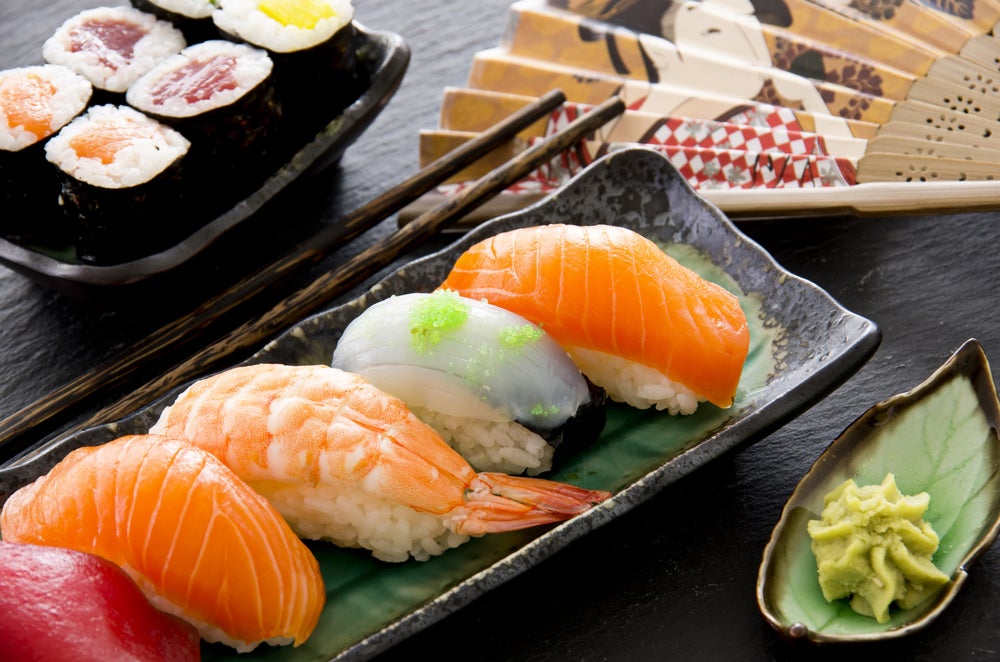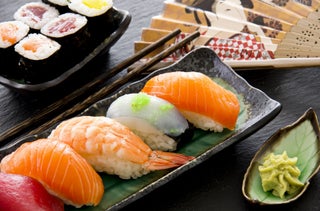The Dish Behind Different Diets Around The World

Photo: Shutterstock.com

One company ventured the globe to see how diets and nutrition trends vary from country to country. We have asked a group of nutritionists to select the best foods and diet tips from around the world that can help us stay healthy, so if you have an abroad race on the calendar, check out which countries can dish up the best pre- and post-race munchies!
Japan
This is one of the healthiest diets in the world. The fish is supplying important omega-3 fatty acids, which are known to reduce the risk of heart disease and strokes. Both the cruciferous vegetables and fermented soya have been shown to reduce the risk of breast cancer as they have a balancing effect on hormones. The Japanese also eat lot of seaweed (sea vegetables) that contains important trace minerals like selenium and iodine for healthy thyroid function. Sushi, the most popular dish in Japan, provides energy but it’s also low in fat and high in omega acids that keeps blood healthy. In general, many Japanese vegetables are unprocessed which means greater levels of vitamins and minerals. —United Kingdom’s leading nutritionist, Dr Marilyn Glenville
Mediterranean
Seafood, olive oil, vegetables, fruit and grains – all these healthy foods, packed with vitamins and minerals, has been linked to a reduced risk of heart disease and diabetes. Although Mediterranean dishes usually contain some cheese and meat, they are used in moderation.
“High amounts of olive oil lower the levels of total blood cholesterol and fight inflammation. Mediterranean diet also emphasizes fish high in omega-3 fatty acids and foods containing antioxidants that can reduce the risk of memory loss and decrease brain function, as we get older,” says Sharon Morey, nutritionist at Quest Vitamins
Iceland
When it comes to food, Icelanders keep things simple—fresh seafood, lean lamb. Most of foods are grown and produced locally with hardly any pesticide use. Dairy products are often higher quality than ours as first Nordic settlers to Iceland had a good knowledge of food preserving.
“High-quality yogurts with beneficial bacteria are a must in Icelander’s daily diet. Fresh fish is high in Omega 3 fatty acids, which help keep our hearts and brain healthy. They can help reduce the risk of dementia and Alzheimer’s as well as heart disease and strokes.” says Dr Glenville.
Sweden
Just like Icelanders, Swedes eat high-quality, fermented dairy products that are crucial when it comes to digestion and immunity (70% of our immune system is in our gut.). Although vegetables don’t play an important role, Scandinavian cuisine still has healthy elements.
“Berries, which are very high in antioxidants, are a favorite fruit in Sweden—usually picked up locally and used in deserts are great source of vitamins. Swedes eat plenty of high quality complex unrefined carbohydrates in the form of rye bread, which is served alongside main meal. Rye is full of fiber and keep us fuller for longer.” adds Dr Glenville.
Ethiopia
Ethiopian cuisine is low in fat and high in nutrients with grains being the main component. Teff – a whole grain high in fiber, iron, protein and calcium is used to prepare most of the dishes.
“Grains are crucial in promoting digestive health and reducing the risk of bowel cancer.” says Dr Glenville. The most famous Ethiopian salad, Azifa, eaten with brown rice or pita bread, comprises green lentil. “Lentils, which are high in fiber and protein but low in fat, are also classed as phytoestrogens with a balancing effect on hormones, both for men and women.” adds Glenville.
China
“Using chopsticks can help you to slow down while eating, which may ultimately decrease the amount of food eaten. Digestion starts in the mouth and as we chew we are releasing salivary enzymes like amylase that begin the breakdown of food, specifically carbohydrates. The more you chew your food, the smaller the particles will be as they pass into the stomach and the easier they are to digest, meaning you will be getting more nutrients from your food from easier absorption. You will find green tea in every Chinese house, which is their favorite hot drink. It eliminates toxins, aids digestion and curbs cravings. It can also fight free radicals, which cause cancer and heart disease,” says nutritionist Elouise Bauskis.
France
How do the French maintain a healthy lifestyle even though their diet is high in fat and carbs? Apart from cheese and baguettes, French also tend to drink red wine with their dinner, which is packed with resveratrol.
“This powerful antioxidant is produced in plants to defend them from invading microorganisms. It can not only protect you from damaging free radicals but it also boosts cell replication. By promoting a healthy, inflammatory response in our body it delays premature aging process. A recent study shows, that there has never been a drug in the history of pharmaceuticals that speeds up cell regeneration like resveratrol. Another study suggests that it can turn an additional weight into calorie-burning ‘brown fat,'” explains nutritionist Michela Vagnini.
India
Indian cuisine includes spices, which not only add flavor and appealing color, but also great health benefits.
“Turmeric has significant anti-inflammatory effects and helps relieve the symptoms of IBS. Ginger is very effective in easing discomfort in the stomach. It also promotes the elimination of excessive gas from the digestive system and soothes your gut,” explains nutritionist Adrienne Benjamin. To refresh themselves, Indians drink Lassi—a traditional, yogurt-based drink. “Made of fermented milk and often flavored with mint or mango, this healthy beverage is rich in ‘friendly bacteria’ and aids digestion,” adds Benjamin.